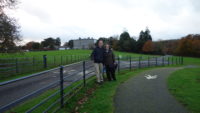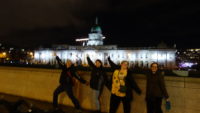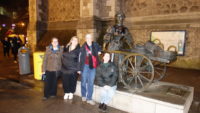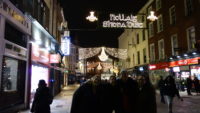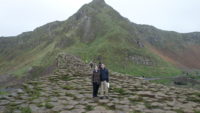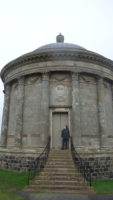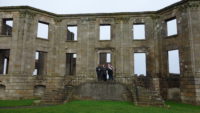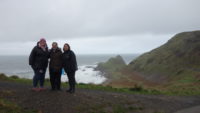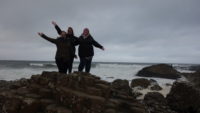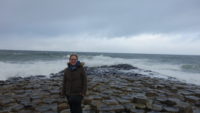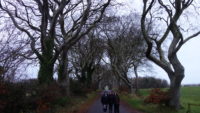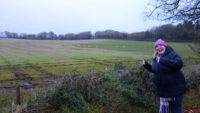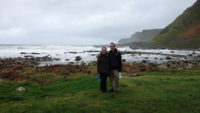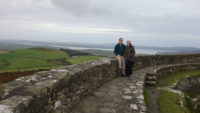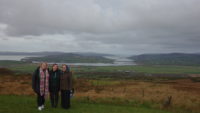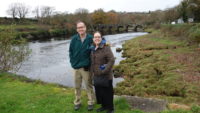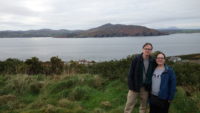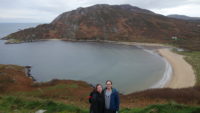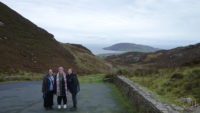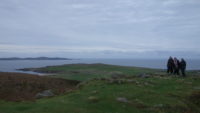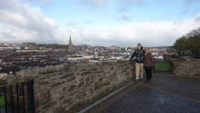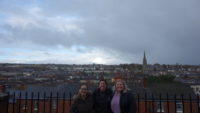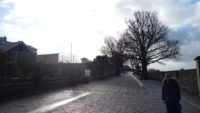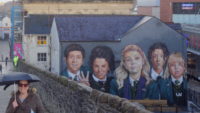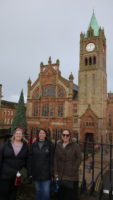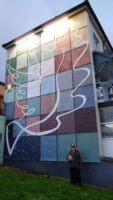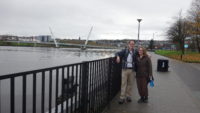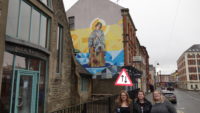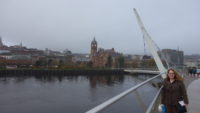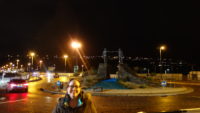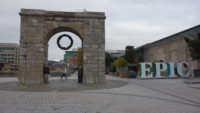 I’m proud of Julia and Sydney. They decided to tackle Dublin on their own today, and it sounds as if they did a magnificent job of it. They got to the National Museum of Ireland when it opened, and took their time looking at bog people and hoards of gold and what-all the museum has. They then went to the National Gallery of Ireland, to which Mer and I haven’t been yet. They said it was really good. At one of the museums (I think it was the art museum), they made a friend of one of the room guards, Gerard, with whom they chatted for some time. The gift of the gab is rubbing off on them! They tried to finish the day with the eclectic Chester Beatty Library and/or Dublin Castle (both are in the same area), but both were closed today for some reason. On the whole, though, they had a great daytime of touring.
I’m proud of Julia and Sydney. They decided to tackle Dublin on their own today, and it sounds as if they did a magnificent job of it. They got to the National Museum of Ireland when it opened, and took their time looking at bog people and hoards of gold and what-all the museum has. They then went to the National Gallery of Ireland, to which Mer and I haven’t been yet. They said it was really good. At one of the museums (I think it was the art museum), they made a friend of one of the room guards, Gerard, with whom they chatted for some time. The gift of the gab is rubbing off on them! They tried to finish the day with the eclectic Chester Beatty Library and/or Dublin Castle (both are in the same area), but both were closed today for some reason. On the whole, though, they had a great daytime of touring.
Meredith, Dubbs, and I walked over the Liffey River a short ways to a recreation of an Irish famine ship, the Jeanie Johnston. The rebuilt ship is seaworthy and sailed to Canada and the US back in the early 2000s and then was used by the Irish navy for training, before Dublin bought it and turned it into a museum. The Johnston was chosen as the ship to rebuild because no one ever died on board the ship, with a total of over two thousand passengers on her various voyages. Even when the original ship sank later as a cargo ship, the crew was rescued after over a week of seeing the ship become more and more waterlogged and slowly sinking during a storm.
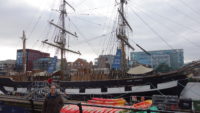 When the potato blight hit the Irish fields in the mid-1840s, the crop failed. Of eight million people Ireland, one million starved and one million left. The ones who left mostly went to North America aboard ships like the Johnston. Most ships had remote owners who were trying to make money, and conditions on ships were poor, which led to the death of one in four passengers. The Johnston was owned by a local owner who knew many of the passengers, so he did what small things he could to improve conditions — he had a doctor on board, he turned away and refunded tickets for anyone who was sick, he required that passengers spend at least thirty minutes a day on deck for air and sun, and he made sure the crew emptied the chamber buckets below decks multiple times each day. The captain himself would go down below decks to visit and cheer the passengers. It seemed to make a difference.
When the potato blight hit the Irish fields in the mid-1840s, the crop failed. Of eight million people Ireland, one million starved and one million left. The ones who left mostly went to North America aboard ships like the Johnston. Most ships had remote owners who were trying to make money, and conditions on ships were poor, which led to the death of one in four passengers. The Johnston was owned by a local owner who knew many of the passengers, so he did what small things he could to improve conditions — he had a doctor on board, he turned away and refunded tickets for anyone who was sick, he required that passengers spend at least thirty minutes a day on deck for air and sun, and he made sure the crew emptied the chamber buckets below decks multiple times each day. The captain himself would go down below decks to visit and cheer the passengers. It seemed to make a difference.
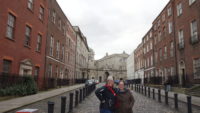 After the ship tour, we walked over to the 14 Henrietta Street museum, which is a museum dedicated to a Georgian house on Henrietta Street, a cul-de-sac of brick houses that were fashionable and expensive in the 1700s. The house was owned by a wealthy family who entertained lavishly. Several of the front rooms have been restored, although there is little furniture in them. After about fifty years, the house became a law office, and then was converted into a tenement house, with the huge home being split into seventeen one- to three-room apartments. The move was good-hearted as a way to solve Dublin’s over-crowding as people moved from the country to the city. The landlord installed gas lighting, running water in the basement, and flushing toilets in the back. It was all considered modern, and so rents were fairly high. To help offset the costs, families had extended family members move in or sublet rooms in the apartments, so that by around 1900, there were over one hundred people living in the house (and that didn’t count “the unfortunate poor” who slept in the stairwell and weren’t counted by the census). As late as the 1970s, there was a family of eight living in one room in the house. Two of the apartments of the house have been restored to how they looked during the tenement days. One was squalid, and one seemed tidy (if cramped). Both have been reconstructed based on scraps of paint, wallpaper, and linoleum that were found on site, as well as interviews with former residents who grew up there in the forties and fifties.
After the ship tour, we walked over to the 14 Henrietta Street museum, which is a museum dedicated to a Georgian house on Henrietta Street, a cul-de-sac of brick houses that were fashionable and expensive in the 1700s. The house was owned by a wealthy family who entertained lavishly. Several of the front rooms have been restored, although there is little furniture in them. After about fifty years, the house became a law office, and then was converted into a tenement house, with the huge home being split into seventeen one- to three-room apartments. The move was good-hearted as a way to solve Dublin’s over-crowding as people moved from the country to the city. The landlord installed gas lighting, running water in the basement, and flushing toilets in the back. It was all considered modern, and so rents were fairly high. To help offset the costs, families had extended family members move in or sublet rooms in the apartments, so that by around 1900, there were over one hundred people living in the house (and that didn’t count “the unfortunate poor” who slept in the stairwell and weren’t counted by the census). As late as the 1970s, there was a family of eight living in one room in the house. Two of the apartments of the house have been restored to how they looked during the tenement days. One was squalid, and one seemed tidy (if cramped). Both have been reconstructed based on scraps of paint, wallpaper, and linoleum that were found on site, as well as interviews with former residents who grew up there in the forties and fifties.
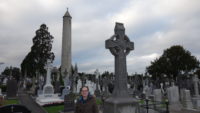 We then grabbed a light lunch and took a cab up to Ireland’s National Cemetery, where almost 1.5 million people are buried, with about 200,000 monuments. I have never seen so many large Celtic crosses before. Multiple famous Irish people are buried there, and we sought out a few. We looked for the writers — the Irish poet and playwright Brendan Behan and the poet/priest Gerard Manley Hopkins, as well as Maud Gonne MacBride, who was a close friend to Yeats. Mostly, we enjoyed wandering and looking at headstones that caught our eye for the beauty of the memorial or for the inscriptions on them. There’s the tallest round tower in Ireland in the cemetery, and several general memorials (including a very moving one from the French to honor the Irish who fought for French causes). It may seem weird to tour a cemetery, but the three of us enjoyed it.
We then grabbed a light lunch and took a cab up to Ireland’s National Cemetery, where almost 1.5 million people are buried, with about 200,000 monuments. I have never seen so many large Celtic crosses before. Multiple famous Irish people are buried there, and we sought out a few. We looked for the writers — the Irish poet and playwright Brendan Behan and the poet/priest Gerard Manley Hopkins, as well as Maud Gonne MacBride, who was a close friend to Yeats. Mostly, we enjoyed wandering and looking at headstones that caught our eye for the beauty of the memorial or for the inscriptions on them. There’s the tallest round tower in Ireland in the cemetery, and several general memorials (including a very moving one from the French to honor the Irish who fought for French causes). It may seem weird to tour a cemetery, but the three of us enjoyed it.
We met back up with Sydney and Julia at the hotel before going out for a quick grab-and-eat supper so we could make our 7:00 time for the National Leprechaun Museum’s presentation of “Dark Tales” — adult versions of Irish folk tales. Mer and I had done this a year ago, and it was a delight again. I love good storytelling, and we heard about banshees and a man who invited the dead to a party, and one or two warring magicians, and more. It was a full hour of stories, and it flew by.
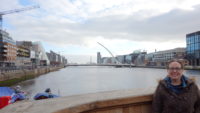 From there we walked back home. That ends the Irish adventure for this time. We leave for the airport in the morning. Dubbs is going to go to the EPIC Irish emigration museum because her flight leaves later than ours, but we’ll go straight to the airport. Ireland and the Irish people have once again been very kind to us, and I hope we can all get back someday. Tomorrow is the long eighteen-plus-hour trip home, but at least we have good company for the journey, with much to recap and discuss.
From there we walked back home. That ends the Irish adventure for this time. We leave for the airport in the morning. Dubbs is going to go to the EPIC Irish emigration museum because her flight leaves later than ours, but we’ll go straight to the airport. Ireland and the Irish people have once again been very kind to us, and I hope we can all get back someday. Tomorrow is the long eighteen-plus-hour trip home, but at least we have good company for the journey, with much to recap and discuss.
